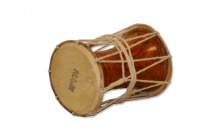 W
WAlghoza is a paired woodwind instrument. It is traditionally used by Baloch, Saraiki, Sindhi and Punjabi folk musicians. It is also used by Kutchi and Rajasthani people. It consists of two joined beak flutes, one for melody, the second for drone. The flutes are either tied together or may be held together loosely with the hands. A continuous flow of air is necessary as the player blows into the two flutes simultaneously. The quick recapturing of breath on each beat creates a bouncing, swinging rhythm. The wooden instrument initially comprised two flute pipes of the same length but over time, one of them was shortened for sound purposes. In the world of Alghoza playing, the two flute pipes are a couple — the longer one is the male and the shorter one the female instrument. With the use of beeswax, the instrument can be scaled to any tune.
 W
WBugchu, also spelled as Bughchu, Bugdu or Bughdu, is a traditional musical instrument native to the Punjab region. It is used in various cultural activities like folk music and folk dances such as bhangra, Malwai Giddha etc. It is a simple but unique instrument made of wood. Its shape is very similar to the damru, an Indian musical instrument. It makes a sound similar to its name, "bugchoo".
 W
WChimta literally means tongs. Over time it has evolved into a traditional instrument of South Asia by the permanent addition of small brass jingles. This instrument is often used in popular Punjabi folk songs, Bhangra music and the Sikh religious music known as Gurbani Kirtan.
 W
WDhadd, also spelled as Dhad or Dhadh is an hourglass-shaped traditional musical instrumrent native to Punjab that is mainly used by the Dhadi singers. It is also used by other folk singers of the region.
 W
WDhol can refer to any one of a number of similar types of double-headed drum widely used, with regional variations, throughout the Indian subcontinent. Its range of distribution in India, Bangladesh and Pakistan primarily includes northern areas such as the Punjab, Haryana, Delhi, Kashmir, Sindh, Assam Valley, Uttarakhand, West Bengal, Odisha, Gujarat, Maharashtra, Konkan, Goa, Karnataka, Rajasthan, Bihar, Jharkhand and Uttar Pradesh. The range stretches westward as far as eastern Afghanistan. A related instrument is the dholak or dholki.
 W
WEktara is a one-stringed musical instrument used in the traditional music of South Asia, and used in modern-day music of Bangladesh, India, and Pakistan.
 W
WThe esraj is an Indian stringed instrument found in two forms throughout the Indian subcontinent, basically it's like a Bowed Sitar. It is a relatively recent instrument, being only about 300 years old. It is found in North India, primarily Punjab, where it is used in Sikh music and Hindustani classical compositions and in West Bengal. The esraj is a modern variant of the dilruba, differing slightly in structure.
 W
WGagar, a metal pitcher used to store water in earlier days, is also used as a musical instrument in number of Punjabi folk songs and dances. It is played with both hands with rings worn on fingers. It is closely associated with the other music instrument, Gharha, which is an earthen pitcher. Gagar is traditionally used by milk venders as milk container also in Majha region of Punjab.
 W
WThe tumbi or toombi, also called a tumba or toomba, is a traditional musical instrument from the Punjab region of the northern Indian subcontinent. The high-pitched, single-string plucking instrument is associated with folk music of Punjab and presently very popular in Western Bhangra music.